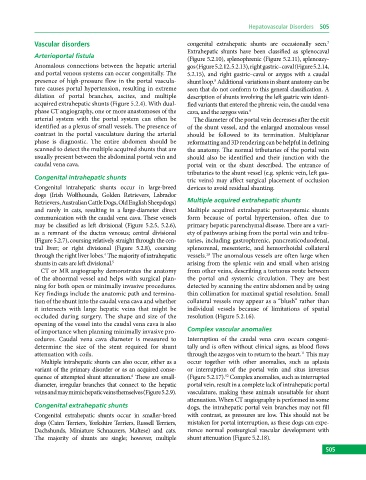Page 515 - Atlas of Small Animal CT and MRI
P. 515
Hepatovascular Disorders 505
Vascular disorders congenital extrahepatic shunts are occasionally seen.
7
Extrahepatic shunts have been classified as splenocaval
Arterioportal fistula (Figure 5.2.10), splenophrenic (Figure 5.2.11), splenoazy
Anomalous connections between the hepatic arterial gos (Figure 5.2.12, 5.2.13), right gastric–caval (Figure 5.2.14,
and portal venous systems can occur congenitally. The 5.2.15), and right gastric–caval or azygos with a caudal
presence of high‐pressure flow in the portal vascula shunt loop. Additional variations in shunt anatomy can be
8
ture causes portal hypertension, resulting in extreme seen that do not conform to this general classification. A
dilation of portal branches, ascites, and multiple description of shunts involving the left gastric vein identi
acquired extrahepatic shunts (Figure 5.2.4). With dual‐ fied variants that entered the phrenic vein, the caudal vena
phase CT angiography, one or more anastomoses of the cava, and the azygos vein. 9
arterial system with the portal system can often be The diameter of the portal vein decreases after the exit
identified as a plexus of small vessels. The presence of of the shunt vessel, and the enlarged anomalous vessel
contrast in the portal vasculature during the arterial should be followed to its termination. Multiplanar
phase is diagnostic. The entire abdomen should be reformatting and 3D rendering can be helpful in defining
scanned to detect the multiple acquired shunts that are the anatomy. The normal tributaries of the portal vein
usually present between the abdominal portal vein and should also be identified and their junction with the
caudal vena cava. portal vein or the shunt described. The entrance of
tributaries to the shunt vessel (e.g. splenic vein, left gas
Congenital intrahepatic shunts tric veins) may affect surgical placement of occlusion
Congenital intrahepatic shunts occur in large‐breed devices to avoid residual shunting.
dogs (Irish Wolfhounds, Golden Retrievers, Labrador
Retrievers, Australian Cattle Dogs, Old English Sheepdogs) Multiple acquired extrahepatic shunts
and rarely in cats, resulting in a large‐diameter direct Multiple acquired extrahepatic portosystemic shunts
communication with the caudal vena cava. These vessels form because of portal hypertension, often due to
may be classified as left divisional (Figure 5.2.5, 5.2.6), primary hepatic parenchymal disease. There are a vari
as a remnant of the ductus venosus; central divisional ety of pathways arising from the portal vein and tribu
(Figure 5.2.7), coursing relatively straight through the cen taries, including gastrophrenic, pancreaticoduodenal,
tral liver; or right divisional (Figure 5.2.8), coursing splenorenal, mesenteric, and hemorrhoidal collateral
through the right liver lobes. The majority of intrahepatic vessels. The anomalous vessels are often large when
4
10
shunts in cats are left divisional. 5 arising from the splenic vein and small when arising
CT or MR angiography demonstrates the anatomy from other veins, describing a tortuous route between
of the abnormal vessel and helps with surgical plan the portal and systemic circulation. They are best
ning for both open or minimally invasive procedures. detected by scanning the entire abdomen and by using
Key findings include the anatomic path and termina thin collimation for maximal spatial resolution. Small
tion of the shunt into the caudal vena cava and whether collateral vessels may appear as a “blush” rather than
it intersects with large hepatic veins that might be individual vessels because of limitations of spatial
occluded during surgery. The shape and size of the resolution (Figure 5.2.16).
opening of the vessel into the caudal vena cava is also
of importance when planning minimally invasive pro Complex vascular anomalies
cedures. Caudal vena cava diameter is measured to Interruption of the caudal vena cava occurs congeni
determine the size of the stent required for shunt tally and is often without clinical signs, as blood flows
attenuation with coils. through the azygos vein to return to the heart. This may
11
Multiple intrahepatic shunts can also occur, either as a occur together with other anomalies, such as aplasia
variant of the primary disorder or as an acquired conse or interruption of the portal vein and situs inversus
quence of attempted shunt attenuation. These are small‐ (Figure 5.2.17). Complex anomalies, such as interrupted
12
6
diameter, irregular branches that connect to the hepatic portal vein, result in a complete lack of intrahepatic portal
veins and may mimic hepatic veins themselves (Figure 5.2.9). vasculature, making these animals unsuitable for shunt
attenuation. When CT angiography is performed in some
Congenital extrahepatic shunts dogs, the intrahepatic portal vein branches may not fill
Congenital extrahepatic shunts occur in smaller‐breed with contrast, as pressures are low. This should not be
dogs (Cairn Terriers, Yorkshire Terriers, Russell Terriers, mistaken for portal interruption, as these dogs can expe
Dachshunds, Miniature Schnauzers, Maltese) and cats. rience normal postsurgical vascular development with
The majority of shunts are single; however, multiple shunt attenuation (Figure 5.2.18).
505

